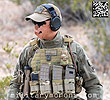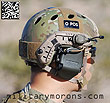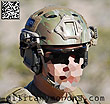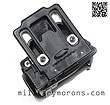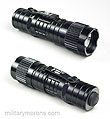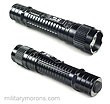Personal Illumination Page 1 Page 2 Page 3 Page 4 Page 5 Page 6
TO VIEW FULL SIZE IMAGES: USERNAME and PASSWORD are both "mm"
Princeton Tec Remix and MPLS Point
| 6/25/10 - Princeton Tec is a name that's been around for years in the personal lighting industry, making lights for outdoors sports use, bikes, scuba and industrial applications. They've recently entered the tactical products arena, and shown here are the Remix headlamp, Remix Pro Headlamp, and the new MPLS Point (Modular Personal Lighting System) Remix Headlamp - The Remix headlamp has an assymetrical single arm bracket, on which the head tilts up and down. Opposite the mounting bracket is a side-accessed battery compartment that houses three AAA batteries. There is a large rubberized push button switch on the top of the head. This turns the light on and off, switches between high and low power, and between the Ultrabright and Maxbright LEDs. The Remix weighs about 3 oz including the batteries, which is light enough to be comfortable with the supplied 1" wide elastic head strap. The Remix is water resistant to 'Level 1', which means that it's resistant to splashing and quick dunkings. The headstrap on all Remixed can be removed and the Remix mounted to 1" molle webbing.
|
|
The Remix has a total of four LED lights in the head - three 5mm Ultrabright LEDs (clustered in a triangle) and 1 Maxbright LED. The Maxbright LED is only available in white, while the Ultrabright are offered in white, green or red (pictured here). The different levels and modes are accessed by pressing the single button. Depending on the last mode it was in, it'll first turn on at the high level (in either Ultrabright or Maxbright mode). Pressing the button quickly switches it to low mode, then off. If the button is pressed and held down, it'll change from Ultra to Max. It's pretty intuitive. Ultrabright - The Ultrabright LEDs emit a smooth, wide beam which is ideal for close to mid-range tasks. On the low setting (4 lumens), the light will run 200 hours while on the high setting (30 lumens) it will last 61 hours. The low setting is suited more for reading in the dark or finding stuff in your tent - you can see the beam out to about 20 feet, but it won't illuminate much at that distance. It's just enough to find your way along in the dark. It has a brighter center with a wide spill. The center spot is about 6" wide at 1-1/2 feet (distance to a book in your lap). Princeton advertises the high setting to reach to about 90 feet. However, this number can change depending on which colour LEDs it has. I found the red LEDs to be useful to about 75 feet (gross estimation), also depending on ambient light conditions, and what I was trying to see. Maxbright - The Maxbright LED lives up to its name. It's pretty incredible how much illumination can come out of an LED nowadays, especially with a reflector. The Maxbright setting produces a narrower, more focused beam. On the low setting, burn time is 53 hours and on the high setting, 28 hours. The high setting is 70 lumens (last year's was 45 lumens) and I'm unable to find out what the low setting is. Advertised distances are about 150 ft for the high and 90 feet for the low Maxbright settings. Again, it depends on ambient lighting conditions and what you're actually using the light for. The Maxbright low setting is close to the Ultrabright high setting, but with a more focused beam. The high setting is impressive, and while was able to light up my house from the advertised distance, it was diffuse enough so that it had limited use. Out to 100 ft and it was plenty bright enough to make out details. This is the brightest LED headlamp of its size that I've tried. I used the Remix on an overnight camping trip and it was plenty bright for all my needs. I like having four settings, and for most immediate tasks, the Ultrabright low or high settings were more than adequate. The Maxbright settings are useful when looking for objects farther away in the dark. They're sometimes too bright for close-up work. The elastic headband is comfortable and I was able to tilt the headlamp up or down to suit all of my needs without moving the headband up or down on my forehead.
|
|
Remix Pro Headlamp - The Remix Pro headlamp is the military version of the Remix. It has the same assymetrical single arm bracket, on which the head tilts up and down. Instead of three AAA batteries, the Pro is powered by by a singe CR123 battery, which was a requirement from the military unit that it was specifically made for. Instead of the black and grey housing of the Remix, the Pro has an all-black housing and rubber button on top. The Remix Pro weighs about 66gr (2.3 oz) including the battery; slightly lighter than the Remix. It's also resistant to splashing and quick dunkings. The configuration of the Remix Pro is identical to the Remix, with three Ultrabright LEDs (available in white, green or red) and one Maxbright LED. The faceplate behind the LEDs on the Pro is black, whereas on the Remix it's mirrored. This is to minimize reflection either at night or in sunlight. The output of the LEDs are the same, but the burn times for the Pro are reduced. On Maxbright high, the burn time is 3.6 hours and on Maxbright low, it's 7 hours. On Ultrabright high, the burn time is 5 hours and on low, it's 40 hours. That's quite a significant different in run time than the Remix. The Remix with its AAA batteries has burn times 5 to 14 times longer than the Pro, depending on the mode. Unless you have no other batteries other than CR123s, it makes more economical sense to go with the Remix. Another difference between the Remix and the Remix Pro is that pressing the 'on' button on the Pro always turns it on in the Ultrabright low mode, no matter whether it was left in the Ultrabright or Maxbright modes last. This to minimize impact of accidentally turning on the light. The Remix always turns on in the high mode first, and either Max or Ultra, depending on which was on last.
|
|
MultiCam - The Remix Pro headlamp is now available in tan, with a Crye MultiCam elastic head band. The MultiCam elastic is of particular interest, as it's woven, not printed. It's really quite amazingly well done. Anyways, for MultiCam junkies like me...YAY! The body of the Remix Pro is tan, as is all the associated hardware. Other headstrap colours available are black, tan and ACU. The one small update to the Remox Pro body is that the fence around the button is taller than the previous versions, which protects the button better from accidental activation. It's a subtle change, but you can see it in the photo below - the black Remix is the older model and the tan one has the higher fence.
|
|
MPLS Point - The other light I brought out with me on the camping trip was the Point , designed specifically for the military as a simple, reliable personal light source with multiple mounting options. It's based off their Pilot LED light, except that it has a more powerful LED located on the end of a flexible boom, which allows you to point the LED where you need it. The Point has a single push button that can be activated with gloves, and has a tactile 'click' when pressed. The button is recessed to prevent accidental activation. The low and high modes are selected by cycling the button quickly (low, high, off). If more than 1.6 seconds elapses since the previous button press, the next press will turn the light off. Turning the light on and pressing for more than 1.6 seconds will result in momentary light output. Releasing the button turns it off. The Point itself weighs only 17g, and measures about 1-3/4"" long, and 1-1/8" wide. The boom and LED head is a little over 3" long. The single Ultrabright LED puts out 10 lumens for a burn time of 36 hours. The LEDs can be had in white, red, blue, green and IR, while the bodies are available in black, OD green (shown here) and sand. The white, blue and green LEDs use two 2016 lithium coin cells, and the red and IR LEDs are powered by a single 2032 cell. The battery compartment is located on the back, and can be opening with a fingernail. Mounts - Now here's the evidence that it was targeted at the military: each Point comes with different mounts - a molle/magnetic mount, helmet mount, a rail (weapon) mount and a 'reverse picatinny" (OPS-CORE helmet) mount. The Point light itself is independant of the mounts, and the idea is to be able to relocate the Point from one mounted position to another, and back. On the back of the Point body are two little 'ears' that fit into the semi-circular channels on the front of the mounts, and the Point is attached by rotating it from 45° into the channels. The channels have ratchets which act as detents at pre-determined angles of rotation. To remove the Point from the mount, it's simple rotated/twisted back off the mount. The Point can rotate about +/- 45° in the mount, then the flexible boom is used to fine-tune the position. The mount should be oriented so that normal rotation under usage of the Point doesn't result in its removal. The molle/magnetic mount has a spring metal clip on the rear, which can be slipped over a piece of molle webbing. It comes with a magnet with an adhesive back, so it can be stuck somewhere and the light then stuck to it for easy access. The rail mount will fit on a weapon or any length of picatinny rail. The reverse picatinny mount fits onto OPS-CORE ARC dovetail rails on helmets.
|
|
The Point boom can be positioned out of the way when not needed. It's just a matter of bending it down and directing the light where you want it when you turn it on. It's so small and light weight that you won't remember it's there until you need it. I found little use for it mounted on a weapon, but I'm sure that there was a role for it there when it was designed. I found it most useful mounted on the head, on a helmet, as it shone where I moved my head. It was easy to turn on and off, and switch between the low and high modes while wearing gloves. In high mode, it's actually bright enough to locate objects 15-20 feet away. Low mode is useful for reading, or close-up personal tasks without over-lighting the area. The boom really makes it easy to point the Point where you need it without having to screw with a mount or running out of travel. It's a neat little system - everyone can make use of a couple of them.
|
MPLS Switch and Remix Pro MPLS
| 4/2/11 - Two of the new additions to the Princeton Tec MPLS line are the Switch and Remix Pro MPLS. The Switch is a dual LED version of the Point, and the Remix Pro MPLS utilizes a different modular mounting system than the regular Remix Pro reviewed previously. MPLS Overview - The Princeton Tec MPLS (Modular Personal Lighting System) comprises of different products and components in the PMLS line that allow the user to configure and personalize his lighting system, whether it be a head lamp, helmet mounted light or otherwise. The lights in the MPLS system are the Point, Switch, Remix and Remix Pro, Tec EOS, Tac Quad, Fuel and Fred. Different mounts are available for these lights which allow them to be used in different manners. Switch-MPLS - The Switch-MPLS is the 2nd generation helmet light, based on the Point-MPLS, which was the original light in the MPLS line. The original Point was called the MPLS, which now refers to the whole system, instead of just one light. The Switch is a dual LED design, vs. the single LED on the Point, and incorporates two Ultrabright LEDs into the head. The addition of a specialty lighting colour besides white is important when accomplishing tasks that require night vision preservation. Like the Point, the head of the Switch is located on the end of a flexible boom, which allows you to point the LED where you need it. The Switch boom is shorter; 1.75" instead of 2.25" on the Point. The Switch as the same single push button that can be activated with gloves, and has a tactile 'click' when pressed. The button is recessed to prevent accidental activation. The Switch will always turn on in the low mode of the specialty colours, and low and high modes are selected by cycling the button quickly (low, high, off). If more than 1.6 seconds elapses since the previous button press, the next press will turn the light off. Pressing the button for more than 1.6 seconds turns on the high white LED - the button is immediately released when it comes on. Pressing and holding the button down for more than 2 seconds cycles the low mode specialy colour and the high mode LED. In this case, the red and white LEDs will flash alternately. The Switch itself weighs only 17g, and measures about 1-3/4"" long, and 1-1/8" wide. The single Ultrabright LED puts out 10 lumens for a burn time of 110 hours. The LEDs can be had in white/green, white/red, white/blue, white/IR and red/IR, while the bodies are available in black, OD green and and tan (shown here). Two 2016 lithium coin cells are used, while a single 2032 cell is used for the red/IR combination. The battery compartment is located on the back, and can be opening with a fingernail. Mounts - The same mounts as for the Point are available for the Switch. A molle/magnetic mount, helmet mount, a rail (weapon) mount and a 'reverse picatinny" (OPS-CORE helmet) mount. The molle mount is a pain to remove from webbing, I found, and is being redesigned I'm told.
|
|
Remix Pro MPLS - The Remix Pro MPLS incorporates a different mounting plate than the standard Remix or Remix Pro. The body itself has the same assymetrical single arm bracket, on which the head tilts up and down. The Pro is powered by by a singe CR123 battery, which was a requirement from the military unit that it was specifically made for. The housing is available in black, olive drab and tan. The Remix Pro weighs about 66gr (2.3 oz) including the battery. It's also resistant to splashing and quick dunkings. The configuration of the Remix Pro MPLS is identical to the Remix Pro, with three Ultrabright LEDs (available in white, blue, green, red or IR) and one white 70 lumen Maxbright LED. On Maxbright high, the burn time is 4 hours and on Maxbright low, it's 7 hours. On Ultrabright high, the burn time is 5 hours and on low, it's 40 hours. The main difference between the Remix Pro MPLS and the Remix/Remix Pro is the MPLS mounting plate. A new mounting plate has been designed which allows it to be installed and removed from different mounts. There are two lower tabs and a single longer center tab. The lower tabs are inserted into corresponding slots on the mount and the longer tab is pushed forward until it locks it in place. To remove it, the tab is pulled (the word 'pull' is molded into the tab) until it clicks free, then the light is removed from the mount. Very simple. The first mount is the Butterfly Bracket which can be used with a head strap and for attaching the light to molle gear. The head strap can be removed, and the mount attached to any 1" wide webbing via the slots in the loops. The mounting plate snaps into the bracket and the the Remix Pro MPLS functions exactly the same as the Remix Pro.
|
|
Ops-Core NVG mount - The other MPLS bracket is the NVG Adapter plate for helmets, designed with Ops-Core and allows the user to quickly attach the MPLS headlamp into a standard shroud as well as the Ops-Core VAS shroud (shown here). The bracket is designed to be very secure, yet provide easy functionality so that the user can quickly add or remove the MPLS light from the helmet mount. The bracket is adjustable in height by loosening up two screws and sliding the bracket up or down, then tightening the screws. The bracket snaps into the NVG shroud much like a normal NVG mount does. There's a little push lever on the right side to detach it from the shroud. The Remix Pro MPLS mounting plate snaps into the NVG adapter bracket exactly the same way as it does on the Butterfly Bracket. The Remix Pro can then be rotated up or down as needed. When in the up position, the 'on/off' button faces inward and is protected from accidental activation. There's also a detent in the 'up/stowed' position that keeps Remix Pro securely stowed. If you're not using your NVGs and need a head lamp when wearing a helmet, this mount is a clean, convenient way of mounting one without straps etc.
|
MINI-LEDs
| 7/30/06 - The
diminutive Arc-AAA light from Arc
Flashlight is small enough to carry on your person every day,
but is amazingly bright for a light of its size. At first glance,
it's easy to dismiss it as another little keychain light like the
Maglite Solitaire AAA light I used to carry with my keys years ago.
But closer examination reveals that this is not your common, cheap
mini-LED light, but more of a miniaturized version of a higher end
light, like a SureFire. It measures only 2.7" long and 0.5"
in diameter, and weighs less than an ounce. Not much larger than a
.308 round, it'll fit almost anywhere unnoticed. I've been wearing
it on my work ID badge that hangs from a cord around my neck. It was
designed to be carried every day - a flashlight isn't much use in
emergencies when you don't have it on you. If you're in the habit
of carrying a tactical light on your belt, the Arc is a perfect backup. |
| 2/6/04 - Here's another neat item I picked up at the SHOT show. I've got a bunch of mini-LED lights - on my keychain, in my bags and gear etc, but none of them are hands-free, so when I saw the QuiqLite, I thought it was a pretty neat idea. It was designed by Brian Quittner - a LE officer. The QuiqLite clips onto your clothing, pocket, or PALS webbing - just about anywhere you can find a spot. The plastic housing forms the clip, and houses the battery. The LED swivels up on an arm through a 90° arc and can be angled anywhere in between to suit your needs. A rubber button on the front is the constant on-off switch. 2 lithium batteries provide about 40 hours of continuous use and it features a 7 minute auto-off timer. They're available with white, blue, red or green LEDs. It's very unobtrusive (about 3" long and 1" wide) and prove very useful when clipped to the front of your vest or LBE when you need that little bit of hands-free light. (Note: this model is now known as the 'Classic Quiqlite') |
| Update 2/4/05 - Another year, another SHOT show, almost to the day. Quiqlite now has a dual LED model - the XP-440, which incorporates 2 super-bright LEDs (available in white/white, blue/white, red/white, green/white, UV and IR models) into the same package as the Classic. The light arm swings open 180° instead of 90°. It also has a removable 'Quiq-clip', which enables it to be clipped to thicker objects. You can turn on one or both LEDs, and it's bright enough to read by when clipped to the collar of my t-shirt with a book in my lap. It can be mounted just about anywhere and is a good alternative to a headlamp for hands-free use. |
| 3/22/06 - The little SO-LED (Special Operations LED) available from County Comm is the same one Crye uses for their Visorlites cap. Instead of a push button, it has a slide switch so you don't have to keep pressure on the switch to keep it on. It's mounted to a small metal clip which rotates 360° with 8 detents. They come in red, white and blue LEDs, and are also available without the clip as simple keychain lights. They're so inexpensive that the batteries cost more than the keychain lights! They'll clip just about anywhere and positioned correctly, you can aim them in the needed direction. |
| OTHER HANDHELDS The hand held flashlight has
come a long way from the Maglites that were so popular a decade ago.
SureFire is at the top end of the quality and price range (but well
worthit, IMHO), with a plethora of other manufacturers snapping at
their heels. A good light can distract or blind an attacker momentarily,
and is always useful when walking in darker areas. There are literally
hundreds to choose from - I have a few 'old school' SF 6Ps, and the
C2 is my only other handheld from SF. I chose it because it can be
used with the SF/Rogers technique when using a handgun. The MK6
Fingerlight on the right from CountyComm
can be bought in red, white or green LED configurations and comes
in a kit with includes a variety of attachment options and a little
pouch. It's a hands-free alternative to the little micro LED lights.
The different mounting options are: Velcro finger attachment, swan
neck clip, and spectacle clip (visit the website for more details).
The plastic housing has a rotating thumb switch at the rear and a
clip to which the other attachments are snapped onto via a ball-and-socket
configuration. The only complaint that I have is that the LED used
doesn't provide an even spot of light, like the other microlights.
It has bright and dark rings. It's the LED, not the clear plastic
protective lens, as I took the lens off and it didn't change anything.
Personally, I'd like to see a better LED used that provides more even
light. |
| 3/22/06 - Digilight
USA offers quite a range of tactical flashlights, from incandescent/Xenon
types to Luxeon LED lights. I've begun preferring the whiter light
of the Luxeon lights, and have been using one of their LXK-53B's for
a while as a general purpose light. It's a 3-watt, 70 lumen light
with a 180-minute run time. It uses two 3V CR123's. The machined body
allows a secure grip and is designed to be used as a hand held light,
as it cannot be mounted in rings on a weapon. The push button tail
cap switch is on/off, and doesn't have momentary capability, which
is my only gripe. The beam is as focused as the P60 incandescent bulbs
on my SureFires.
|
|
The 24/7 housing is available in yellow and a very dark OD green/black. It will stand up on its own, either upright or on its side. The light can be bought by itself or with an accessory kit, which provides a variety of mounting options - head strap mount, 4 wall brackets (mounted with screws or double-back tape), magnetic mount, and neck strap. The head mount and magnetic mount both swivel to allow angle adjustment. The LEDs on this thing are very bright and can be seen quite easily during the day, and from quite far away at night. Turn the 3-colour signal on while following a car at night and they'd probably pull over to the side of the road. It's a useful little light with a variety of uses. It's small enough to use while jogging, or bicycling. It kicks ass over the LED tail light I have on my bicycle. I carry it with me as much as possible - never know when I'll need it in a roadside emergency or just need a flashlight. Note that it is water-resistant, NOT submersible. I got them at TRgear - tell Woody or Keith I sent ya. |
CARRYING BATTERIES
| 6/4/07 - Okay, so you've got all these lights, electronics and optics - where do you carry the batteries? TAD Gear offers their compact BC4 and BC8 pouches made specifically to fit the Batuca battery cases. The Batuca battery cases are made of translucent injection molded polymer, and measure 2.7" wide x 2.3" tall x .75" thick. The lid is a flip-top, and is not waterproof. Each Batuca will hold 4 AA, 6 AAA or 4 DL123 batteries, or combinations. There are internal ribs to hold the DL123 batteries at the top of the case, since they're shorter than AAs, and you can fit Aimpoint batteries in the space underneath the 123s. The Batuca cases are pretty much the most compact way of carrying batteries as there is very little wasted space. Two Batuca cases can be joined together at the bottom by sliding them together. The BC4 and BC8 cases are sized to fit one or two Batuca cases exactly, and add only about .1" to the overall dimensions. They're made out of 500D cordura and lined with smooth Oxford nylon. Both cases have 1" wide velcro belt loops to fit up to 2" wide belts. They're molle-compatible and will fit on 2-inch systems like on the FAST pack waistbelt, where the 2" webbing is sewn down 2 channels of PALS apart. The BC4 and BC8 have velcro-closure lids with a pull tab. The pouches can also be used for small items other than the Batuca cases - the BC8 fits my compact digital camera perfectly without bulk, and the BC4 is the perfect pouch for the SureFire helmet light shown below. The BC4 holds my pager horizontally on my belt, which is more comfortable than the vertical holder it came with.
|
SIGNALS
| 8/5/06 - These
are TAD
Gear's Ranger Eyes; cool little glow-in-the-dark skulls that can
be used the same way luminous tape is used on USGI helmet bands with
cat eyes - for identification at night. |
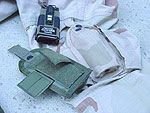  Custom Strobe pouches from High Speed Gear. I asked Gene to make me some custom strobe pouches of my own specifications in olive and 3-colour desert. The construction is first-class! |
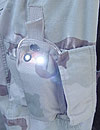 3-colour desert strobe pouch sewn to arm, while flashing |
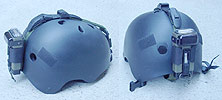 Strobe attached to the back of protec half-hat helmet. |
|
ATTENTION! PLEASE DO NOT LINK DIRECTLY TO MY IMAGES
-
IT RESULTS IN MY BANDWIDTH ALLOCATIONS BEING EXCEEDED,
AND MY PAGES GO DOWN. THANKS!
/ . PLEASE
OBSERVE AND RESPECT OUR COPYRIGHT! . /
©opyright by MilitaryMorons.com. All Rights Reserved. Reproduction, Duplication,
Distribution Strictly Prohibited.
Unless mentioned otherwise, content and images are the
property of militarymorons.com and are not in the public domain.
They are not to be used without
permission. Please Contact
me for permission to use any images or content herein.





















